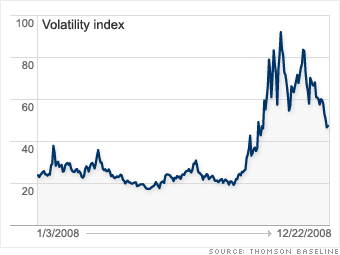
Dow closed at: 8,579.19
Change in points: -678.91
Percentage change: -7.33%
The Dow fell 2,400 points, or 22%, in the eight sessions spanning Oct. 1 to Oct. 10 - a drop not seen since the 1930s.
Thursday, Oct. 9 was the worst in the eight-day slide. Investors' fears about the ongoing credit crisis mounted after the Treasury Department said that it would purchase equity stakes in banks.
Announced just a week after Congress approved the $700 billion bailout plan, the plan marked a change from Treasury's initial intent, which was to buy up mortgage-backed securities from banks. While Treasury didn't rule out buying up banks' "toxic assets" (at that point, at least), it decided to focus its efforts on the equity-stake purchases. The market shunned Treasury's strategy shift.
The Chicago Board Options Exchange volatility index, a key measure of investor fear, rose as high as 64 on Oct. 9, the first time the measure ever rose above 60. Later in the month, the index would soar to nearly 90 before falling in the next few months back below 50 as the government's bailout actions took hold.
The so-called VIX typically trades at around 15-20, and never rose above 30 before this year. The index erupted when the credit crisis hit in mid-September and is still running at double its typical level.
NEXT: Sep. 15 - Lehman collapses, credit crisis begins
Last updated December 29 2008: 2:39 PM ET
